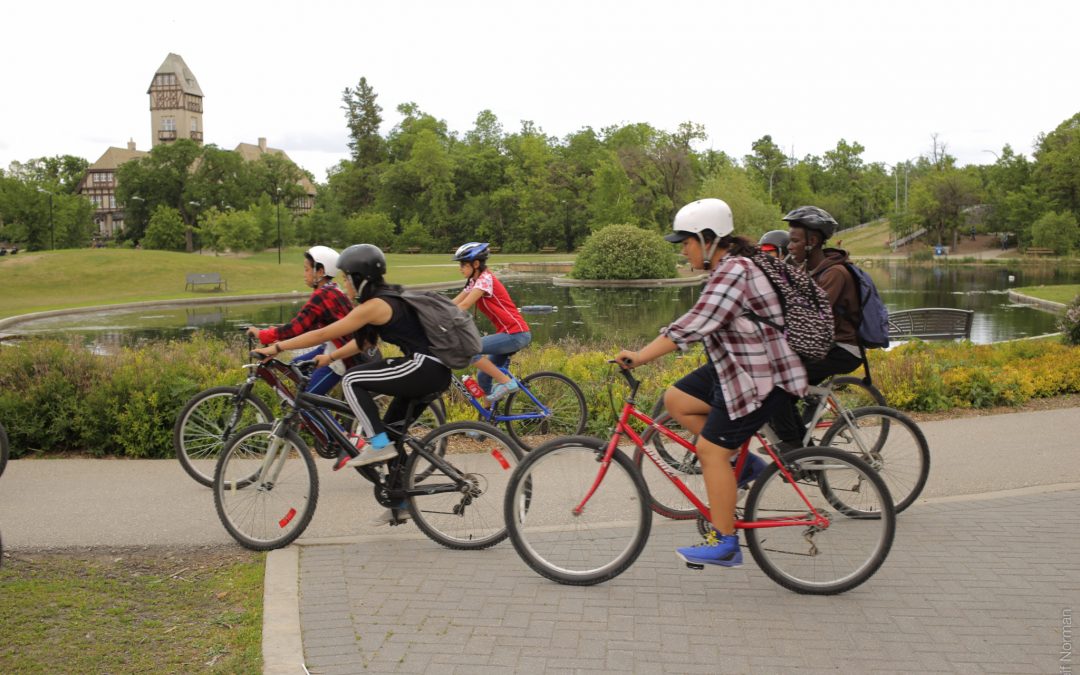There is no doubt about it. Canadian kids’ health is suffering because they aren’t active enough.
- In ParticipACTION’s 2018 Report Card, Canadian children scored D+ for physical activity. Only 35% of 5- to-17-year-olds meet the physical activity recommendation within the Canadian 24-Hour Movement Guidelines for Children and Youth (2014-15 CHMS, Statistics Canada).
- We also scored a D- for active transportation. Based on parent- and self-report data on 5- to 19-year-olds in Canada, 21% typically use active modes of transportation (e.g., walk, bike), 63% use inactive modes (e.g., car, bus) and 16% use a combination of active and inactive modes of transportation to travel to and from school (2014-16 CANPLAY, CFLRI).
- In our Making Children Count report, we found that only 1 in 3 students walk/wheel to school in Manitoba.
To reverse the trend, we need strong policies that prioritize active school travel and make it easier for more families to choose active school travel. But parents and teachers can have a huge influence! Here are ways to work within what we have and set children up for healthy habits by taking action today.
Teachers at School:
Bronze Initiatives
- Take part in special events that promote and celebrate active transportation, like Walktober (October), Bike to School Month (May), Clean Air Day (June), and Winter Walk and Wheel Week (February)). Tailor these events to your school’s resources. A great single-day event is much better than a so-so month!
- Collect data on how your students are getting to school. Our app, BikeWalkRoll, makes it easy to calculate this with simple 30-second classroom surveys. You can then compare your school’s score with schools across Manitoba. As a bonus, these surveys also help us monitor how transportation trends are changing over time.
- Integrate active travel into the material you’re already teaching. See the Curriculum Integration section of our resource guidebook for how it can be incorporated at all grade levels.
Silver Initiatives
- Make the case as to why active transportation should be a priority at your school/division with this comprehensive report Saving Time and Money with Active School Travel.
- Work to create a school policy around traffic management. This could consist of “No Stopping” zones during drop-off and pick-up, along with designated areas for drop-off and pickup.
- Make sure your school community supports active transportation. Fundraise for secure bike racks, recruit volunteers for walking school buses, talk with your city councillor about infrastructure concerns, training crossing guards or patrols for key intersections, and ensure that walking and biking paths are usable in the winter.
Gold Initiatives
- Taking the best from all of the above, School Travel Planning is an international best practice that identifies and resolves barriers to walking and biking to school. ASRTS can guide you in developing your plan, conducting surveys and consulting with community stakeholders to develop action plans.
Parents At Home:
Bronze Initiatives
- Build in some extra time for you to walk or bike with your children to school. Most of us could use a little more exercise and time outdoors. If this doesn’t work for your schedule, see if you can find a family member or neighbour that can walk or bike to school with your children.
- If you must drive, you can still do your part by parking a short distance away from the school and either walking your child to school or letting them walk to school on their own. Similarly, arrange to pick up your child at a designated location a short distance from the school, especially on a walking route that their friends take!
- When it’s not possible to avoid driving, try carpooling with another family. This means one less car contributing to traffic congestion and air pollution in the area around the school, which helps everyone! Combine with Park and Walk for bonus points!
- Discuss the low rate of active school travel with friends and acquaintances, and talk about what actions you can take.
Silver Initiatives
- Make active and healthy living a priority all week long. Getting children to play outside after school or on the weekend gets them accustomed to an active lifestyle, making active travel to school an easy transition.
- Rethink convenience. Instead of chauffeuring kids around until they can drive on their own, take the time to walk, bike, and take transit with your child. This way, you’re equipping them with skills for staying healthy and getting around independently —now that’s convenient! Manitoba Public Insurance offers information and resources for teaching street safety to children.
- Children are very observant, so make sure you’re walking the talk! Use active travel to get to work, even just once a week to start. Visit Workplace Commuter Options‘ page for resources to help you start actively travelling to work.
Gold Initiatives
- Advocate for active school travel with your children’s school, parent council, or your local City Councillor.
- Coordinate or lead a Walking or Cycling School Bus, which consists of two or more families travelling together to or from school. Volunteer parents who live in close proximity to each other walk or bike with children as one collective group or “bus”, sharing the responsibility and building social networks along the way.




Recent Comments